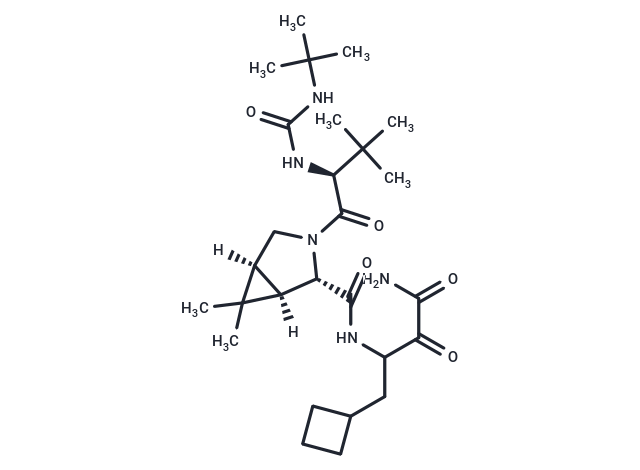Shopping Cart
- Remove All
 Your shopping cart is currently empty
Your shopping cart is currently empty

Boceprevir (SCH 503034) is a novel, potent, highly selective, orally bioavailable HCV NS3 protease inhibitor with Ki of 14 nM in both enzyme assay and EC90 of 350 nM in cell-based replicon assay.

| Pack Size | Price | Availability | Quantity |
|---|---|---|---|
| 5 mg | $65 | In Stock | |
| 10 mg | $98 | In Stock | |
| 25 mg | $153 | In Stock | |
| 50 mg | $197 | In Stock | |
| 100 mg | $318 | In Stock | |
| 1 mL x 10 mM (in DMSO) | $74 | In Stock |
| Description | Boceprevir (SCH 503034) is a novel, potent, highly selective, orally bioavailable HCV NS3 protease inhibitor with Ki of 14 nM in both enzyme assay and EC90 of 350 nM in cell-based replicon assay. |
| Targets&IC50 | HCV NS3 protease:14nM(Ki) |
| In vitro | In the HCV NS3 protease continuous assay, Boceprevir (SCH 503034) has a potency of 14 nM (Ki) average over a large number of runs. In the 72-h bicistronic subgenomic cell-based replicon assay in HuH-7 cells, the EC50 and EC90 values are determined to be 0.20 μM and 0.35 μM, respectively. Boceprevir is also found to be a very weak inhibitor of HNE (Ki=26 μM) representing a selectivity of 2200. |
| In vivo | Boceprevir is a chemical compound designed as an HCV Protease Inhibitor for treating Hepatitis C Virus Infection. Its pharmacokinetic properties have been assessed across different animal species. Following oral administration, Boceprevir exhibits moderate absorption in rats (10 mg/kg), dogs (3 mg/kg), and monkeys (3 mg/kg), with absorption being relatively quicker in dogs compared to slower rates in mice (10 mg/kg), rats, and monkeys, as indicated by mean absorption times (MAT) of 0.5 to 1.4 hours. The compound demonstrates effective area under the curve (AUC) values in dogs and rats, moderate values in mice, and lower values in monkeys. Its absolute oral bioavailability ranges from modest (26-34%) in mice, rats, and dogs, to low (4%) in monkeys. Additionally, Boceprevir, at a dosage of 100 mg/kg orally, effectively inhibits HCV NS3/4A protease activity in triple-transgenic mice. |
| Alias | SCH 503034, EBP 520 |
| Molecular Weight | 519.68 |
| Formula | C27H45N5O5 |
| Cas No. | 394730-60-0 |
| Smiles | C(NC(CC1CCC1)C(C(N)=O)=O)(=O)[C@@H]2[C@@]3([C@@](C3(C)C)(CN2C([C@@H](NC(NC(C)(C)C)=O)C(C)(C)C)=O)[H])[H] |
| Relative Density. | 1.162 g/cm3 |
| Storage | Powder: -20°C for 3 years | In solvent: -80°C for 1 year | Shipping with blue ice. | |||||||||||||||||||||||||||||||||||
| Solubility Information | DMSO: 91 mg/mL (175.11 mM), Sonication is recommended. | |||||||||||||||||||||||||||||||||||
Solution Preparation Table | ||||||||||||||||||||||||||||||||||||
DMSO
| ||||||||||||||||||||||||||||||||||||

Copyright © 2015-2025 TargetMol Chemicals Inc. All Rights Reserved.